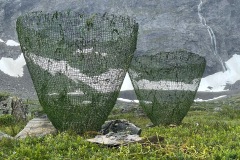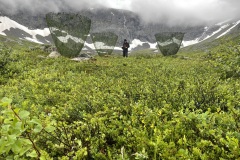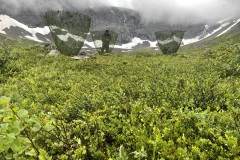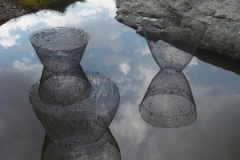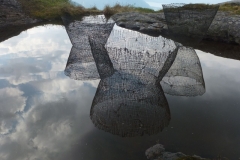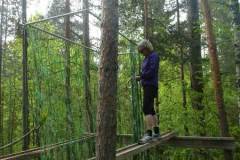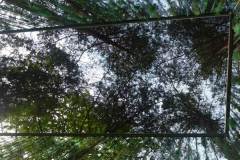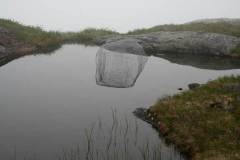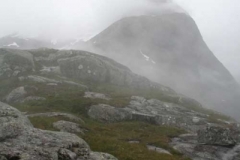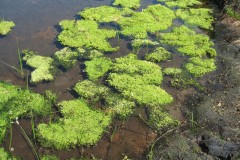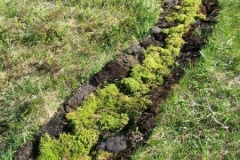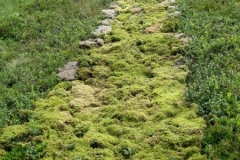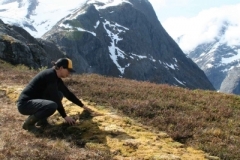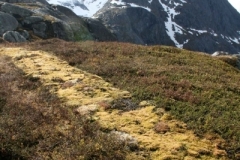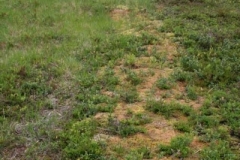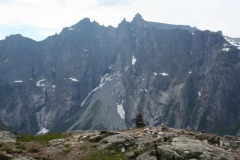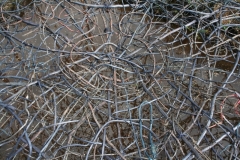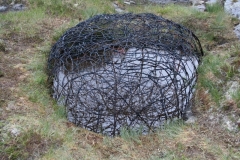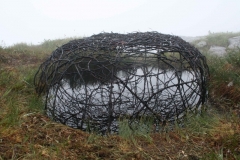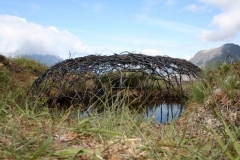Green Ultima
2022
90-105 cm diam, 80-100 cm high Cotton, linen and hemp thread, hardened with resin.
Earlier I did the project «Ultima in the mountains», where three Ultima baskets where placed in a pond on the mountain Litlefjellet in Vengedalen.
In this years project, the baskets are placed in the bottom of the valley. I try to make them appear as a part of the landscape.
Vengedalen has for generations been an important mountain valley, where the cattle were grazing all summer. With «The Green Ultima» I want to emphasize the importance of the seter valleys as a food resource, where baskets were often used to carry the feed in.
They can stand as a counterpoint in a culture that is more and more about conquering the mountain peaks, rather than live with the mountains and to reap what the seter valleys has to offer.
Ultima in the mountain
2015
90-105 cm diam, 80-100 cm high Cotton, linen and hemp thread, hardened with resin.
I was curious to see the Ultima vessels as part of Kunst I Natur/ Art in Nature.
Making the Ultima vessels is for me a way to express our vulnerable lives and civilization, and I wanted to see what they would look like in these untamed natural environments.
Technically they managed very well, standing in the water for several weeks without being damaged.
Ultima in the pond
2018
In the autumn 2018 I had a solo exhibition at Romsdalsmuseet, the local museum in my hometown Molde. There is a pond at the museum area, and I used the opportunity to exhibit three of the Ultima vessels in the water.
I felt that in these surroundings, the vessels got a stronger symbolical effect, where the issue of the climate change and our vulnerability was strengthened.
Kongle
2013
180 x diam 65 cm. Sculpture made of iron wire.
I wanted to make an outside construction that would capture the magic of the snow; the snow on the wires is a beautiful sight.
The original idea was to hang the sculpture from a branch. However it ended up on the corner of our house, where it is very exposed to changing weather conditions.
Celestial Bed/ Himmelseng.
2012
Gjertrud Hals and Christine Istad.
200x90x250 cm Mixed media (metal bed, wire, beard lichen, wool).
Celestial Bed was made for the project Lost Garden at Høvikodden. Lost Garden took place in the summer of 2012, initiated by the Visual Artists in Bærum and prepared in collaboration with Henie Onstad Art Centre.
Celestial Bed was made as a place to contemplate, get inspired, energetic, to hide or to relax, where the spectator was invited to lie down. The iron bedstead from 1910 had belonged to the opera singer Kirsten Flagstad (!) and was draped with beard lichen.
Beard Lichen is a unique organism, highly sensitive to environmental disturbances, functioning as nature’s own sensor.
Floating stone
2011
Gjertrud Hals and Torill Brosten.
Ca 200 x 100 x 80 cm. Metal wire mesh.
We took the shape of an existing stone and constructed an object that had a similarity with the real stone, trying to show the connection between them. The new, «floating stone» related to the original one, however with its own expression and identity
From here I can see the Valley/ Her kor eg står kan eg sjå dalen.
2009
Gjertrud Hals and Torill Brosten.
Ca 80 x ca 500 cm. Moss, turf, peat.
Art in Nature/Kunst i Natur is an annual meetingpoint for international and local artists.
It takes place in Vengedalen, Isfjorden and is a part of Norwegian Mountain Festival/Norsk Fjellfestival.
Torill and I wanted to make a classic land art piece, created of material from the nearby surroundings. We ended up making a «moss river», linked to the Rauma river we could see deep down in the valley. We also wanted the artwork to change by time, and gradually go back to nature. The photos are taken through three summers, showing how the moss river gradually became more and more invisible.
Small pond/ Liten dam
2007
Small pond/Liten dam.
Diam ca 250, 40 cm high. Dyed roots from fur and birch trees.
Small Pond was a part of Kunst i Natur/ Art in Nature, that took place in the mountains near Isfjorden/Rauma. Kunst i Natur started in 2002, and has been an annual meeting point for international and local artists.
In 2007 I made a root structure over a small pond, in a way that made it look deeper and gloomier than it actually was.

